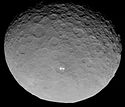Calathus Mission

Occator Crater on Ceres
Calathus is a proposed student-designed Ceres sample-return mission, that would consist of an orbiter and a lander with an ascent module. The orbiter would be equipped with a camera, a thermal imager, and a radar; the lander will have a sampling arm, a camera, and a gas chromatograph mass spectrometer. Mission objective is to return maximum 40 g of Ceresian soil.[1] The mission was designed and proposed in 2018 with support of ESA.[2]
Spacecraft should take samples from Occator Crater,[2] that was studied and photographed by NASA's Dawn. The objectives are:[2]
- to understand whether Ceres contains ingridients for life
- to understand where Ceres was formed
- to understand whether asteroids like Ceres were responsible for delivering water and organics to Earth
Further reading[]
- "The Calathus Mission" (PDF). Alpbach Summer School.
- "SAMPLE RETURN FROM A RELIC OCEAN WORLD: THE CALATHUS MISSION TO OCCATOR CRATER, CERES" (PDF). 51st Lunar and Planetary Science Conference (2020). 2021.
References[]
- ^ Gassot, Oriane (April 2021). "Calathus: A sample-return mission to Ceres". Acta Astronautica. 181: 112–129. doi:10.1016/j.actaastro.2020.12.050.
- ^ a b c "The Calathus Mission Concept to Occator Crater at Ceres: Science, Operations and Systems Design" (PDF). ESA.
Categories:
- Proposed space probes
- Ceres (dwarf planet)
- Missions to dwarf planets
- Missions to main-belt asteroids
- European spacecraft stubs

